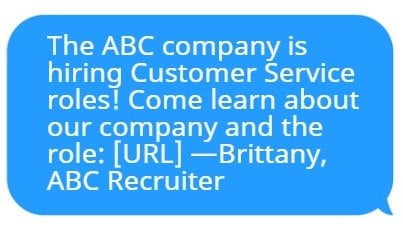Online marketing is all you hear! Banner ads, social media, video ads, and all the incredible offerings of the Internet have oohed and aahed advertisers for years—even decades now. With the huge popularity of smartphones, ads can now be shown wherever a person is. With this amazing platform at the tips of our fingers, it’s hard to imagine what will come next. I’m here to remind you that there’s a great way to market with a tool that has been around since 1992!
According to the Pew Research Center, 96% of American adults have a cell phone, 71% of which are smartphones. Either way, all cell phones can receive SMS (Short Messaging Service) messages. SMS, more commonly known as text messaging, is a great way to market to potential candidates. SMS is often overlooked because the FCC has stricter guidelines than other forms of marketing, (found under the Telephone Consumer Protection Act - TCPA).
One-Way vs. Two Way Campaigns
First, you must build an audience to send a message to (consider using your internal CRM or a third-party service). After you’ve found your audience, it’s time to decide whether you want to send a one-way text message or a two-way campaign. Many SMS platforms offer two-way SMS, which allows a recruiter or chatbot to engage with the audience. Potential candidates may have questions that the recruiter/chatbot can answer. One-way campaigns send a simple message out without the need for a system or recruiter to monitor the responses. Two-way campaigns, despite being more complex, are great for engagement. No matter what type of campaign is chosen, it’s important that you spend some time crafting the message.
The Message
SMS copy is tricky because it cannot be too long (usually around only 160 characters!) but needs to be long enough to give your audience some context for what you are promoting. It may seem easy to come up with SMS copy, but once you start, you may realize how challenging it is.
7 Tips to Help with SMS Marketing
1. Company NameA company name may seem obvious, but sometimes it’s easy to forget. Sending something vague like “We are hiring!” gives the audience no context as to who the sender is. Act as if you are the receiver of the text when proof-reading potential SMS copy. Is this copy descriptive enough to give you context? Do you feel safe clicking on the URL? Including the company name will alleviate some of these issues.
2. Add Pictures & Videos
Sending pictures and videos upgrades an SMS to an MMS (Multimedia Messaging Service) where there’s a visual sent along with the message. Don’t send something random. Make sure the picture or video has context in the message. Also, beware of poor-quality videos. Each phone service has limits on the size of files they can receive. Most videos will need to have the file size reduced, which will reduce the quality of the video. Make sure that the video is still high-enough quality to be able to send. If the video is grainy or slow, it will be a poor experience for the user. In these cases, it’s better to opt for a picture instead.
3. Vanity URL
A vanity URL is is a “long URL that has been converted into a customized short link”. Vanity URLs are important in SMS messages for two reasons:
- Character Count: Keeping the SMS copy within a certain character limit will be hard with a long, complex URL taking up a lot of space. Using a vanity URL can decrease the length of the URL.
- Ease of Mind: Vanity URLs allow the audience to feel more secure about clicking on the link. In our tech-savvy world, most people have learned the hard way that clicking on random, untrustworthy URLs can lead to trouble on their devices. A vanity URL is a way for a company to clearly state their brand and give their audience confidence that the link is safe to click on.
4. Add a Personal Touch
Adding a personal touch to an SMS could be the difference between someone reading the message and someone just glossing over it. Most SMS technology can use first names, which can make a message much more enticing for a reader.
Example:

Another way to personalize without using the receiver’s name is to include a recruiter’s name at the end as a sign off. Again, this helps promote confidence in your reader that this is a legitimate offer and not spam since they would be communicating directly with the recruiter.
Example:

Both options will make the SMS seem way more personal to the receiver, which will make them more likely to positively read the message and respond to it.
5. Frequency—Don’t Send Too Many!
Frequency is very important with SMS marketing. The amount of SMS the audience can receive per month from your company is decided in the original opt-in language. If your audience has consented to receiving five messages from your brand per month, that does not mean that you must send five per month. Overloading potential candidates with multiple meaningless texts will only push them away from your brand. An annoyed audience is an unresponsive one.
Finding a balance between keeping the candidates interested and in the know about the company versus bombarding them with multiple messages they don’t care about can be tricky. Before sending another SMS, ask “Is this information relevant to my audience?”. If the roles or events you’re promoting match the person’s specific set of talents or their location, then the message is probably relevant enough to send. If not, then hold off on sending something to them until you have something relevant to them.
6. Follow the Rules
Companies need to be careful that people receiving their messages are “opted-in” to receiving the SMS, or else it is considered spam. Sending spam texts is illegal under the TCPA. Consider having candidates fill out a form with specific opt-in language or using a third-party SMS vendor to help assist with the opt-in process. Always use a double opt-in process to guarantee the legality of the SMS. In addition to having people “opt-in”, SMS messages need to always include an “opt-out” capability for their subscribers. Usually this is in the form of the phrase, “Text STOP to unsubscribe”. Learn more about the legal requirements of SMS marketing in this guide. Also, browse through information about the double opt-in process here.
7. Bonus Tip
The last bonus tip is the most important: Even when you are busy, late, or very late, always (and I do mean always!) proofread and send yourself a test SMS before sending it to your audience. You do not want to be in a situation where you notice a typo in your copy a couple of seconds after you send a mass SMS to some of your warmest candidates!
Using these tips will help set you up for success when launching your SMS campaign. Happy texting!
--
What tips would you add? Let’s talk! We’re happy to help you navigate through your campaign—just give us a shout.



